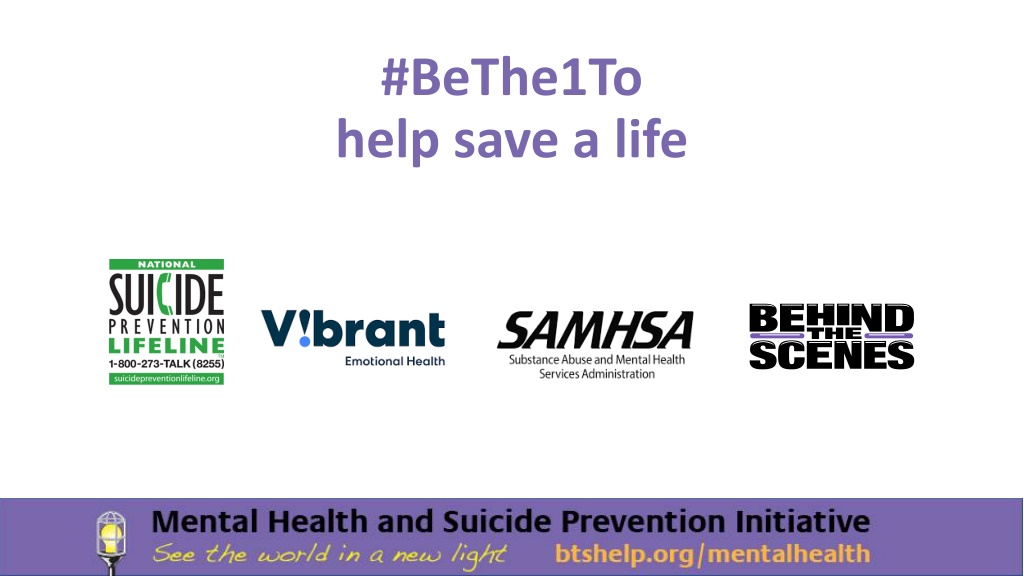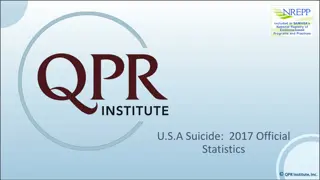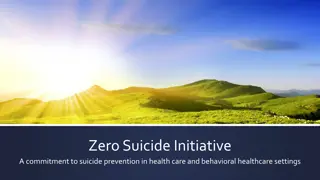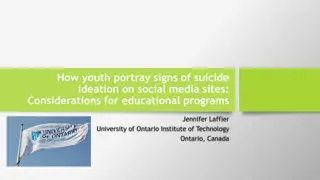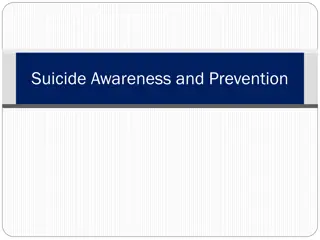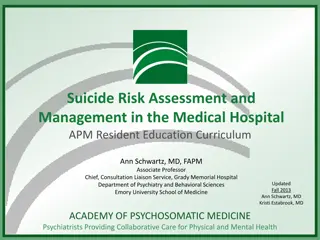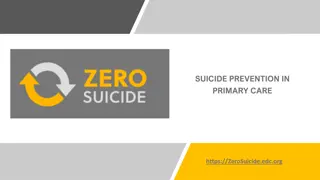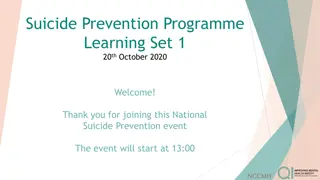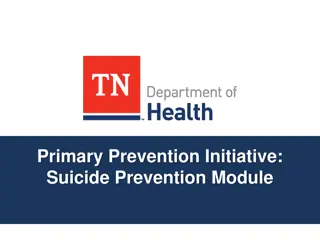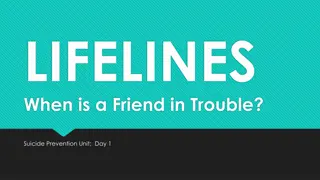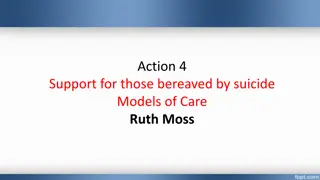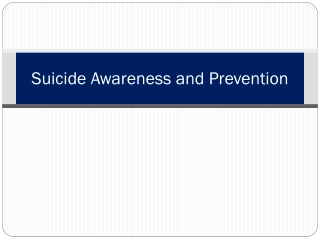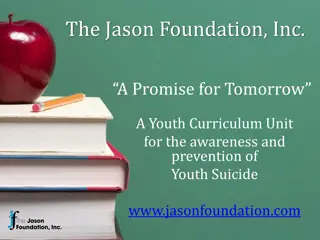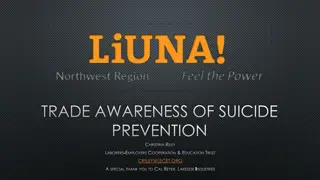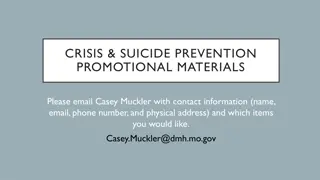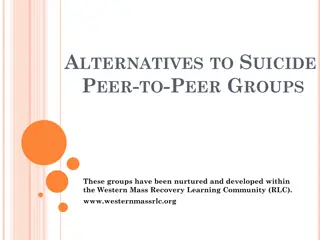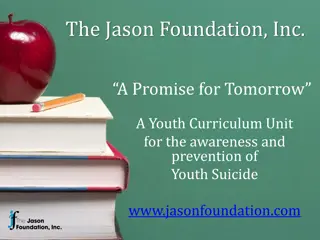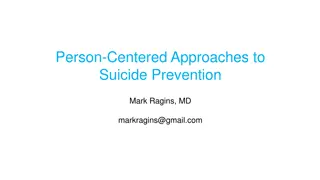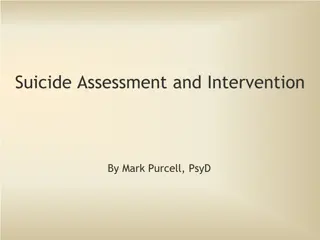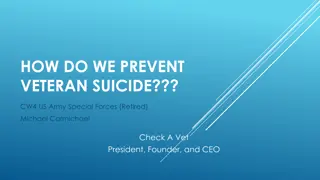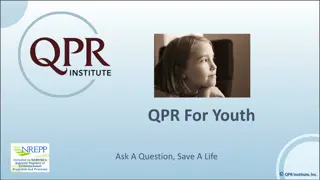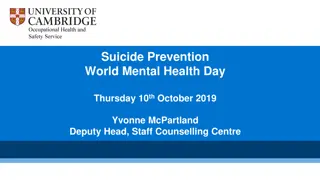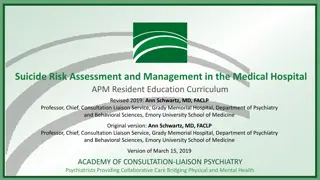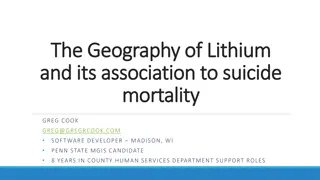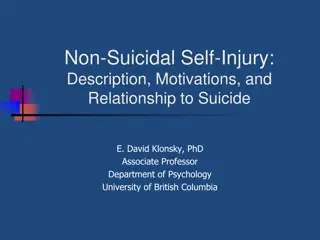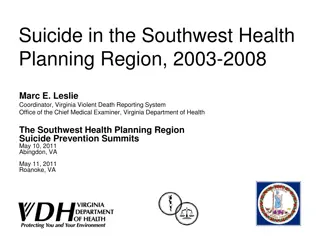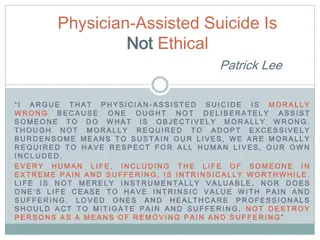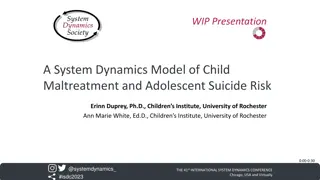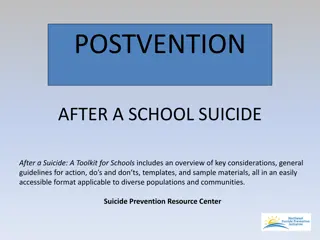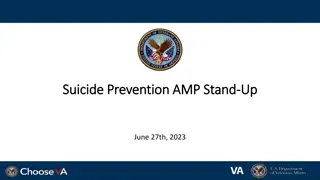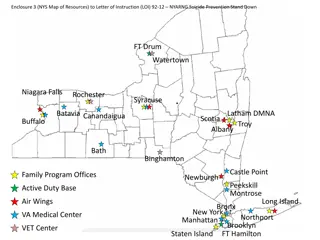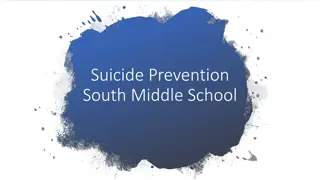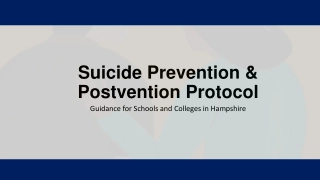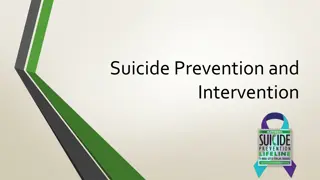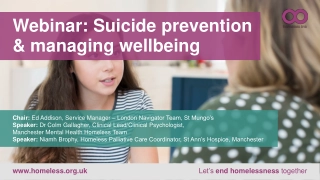Steps to Help Save a Life: Suicide Prevention Communication
Learn the evidence-based five action steps for communicating with someone who may be suicidal: Ask, Be There, Keep Them Safe, Help Them Connect, and Follow Up. Use open-ended questions, reflective listening, and pay special attention to those struggling during Covid-19.
Download Presentation

Please find below an Image/Link to download the presentation.
The content on the website is provided AS IS for your information and personal use only. It may not be sold, licensed, or shared on other websites without obtaining consent from the author. Download presentation by click this link. If you encounter any issues during the download, it is possible that the publisher has removed the file from their server.
E N D
Presentation Transcript
#BeThe1To help save a life
#BeThe1To help save a life The five action steps for communicating with someone who may be suicidal are supported by evidence in the field of suicide prevention. 1. ASK 2. BE THERE 3. KEEP THEM SAFE 4. HELP THEM CONNECT 5. FOLLOW UP
1. ASK Asking WILL NOT encourage suicide. There are no magic words to say. Use words that feel honest and accurate. 1. ASK 2. BE THERE 3. KEEP THEM SAFE 4. HELP THEM CONNECT 5. FOLLOW UP
Trust your observations. You seem sad. Are you thinking about hurting yourself? You seem to be troubled. Are you thinking about suicide? You seem distressed. Are you thinking about ending your life? 1. ASK 2. BE THERE 3. KEEP THEM SAFE 4. HELP THEM CONNECT 5. FOLLOW UP
Ask open-ended questions rather than yes/no questions. What are you feeling? What upsets you the most? What's been happening in your life? Why do you think you're feeling like this? What would you like to be different about your life? 1. ASK 2. BE THERE 3. KEEP THEM SAFE 4. HELP THEM CONNECT 5. FOLLOW UP
then LISTEN Listening is as important as asking questions. Help them focus on their reasons for living not your reasons Take their answers seriously Never dismiss or contradict Don t be judgmental Ask reflective follow-up questions - Repeat back what you've heard and let them know you understood what they said 1. ASK 2. BE THERE 3. KEEP THEM SAFE 4. HELP THEM CONNECT 5. FOLLOW UP
Heres an example of reflective listening: You: You seem very upset. Are you thinking about harming yourself in any way? Them: I m thinking that dying is the only way to end the pain. You: You're really hurting. What are some of the things that are troubling you? Them: Everything. You: It sounds like you feel overwhelmed. Tell me just a little about some of what's making you feel so bad. Them: I can't do anything right, and no one takes me seriously. You: I take you seriously, what can I do to help? 1. ASK 2. BE THERE 3. KEEP THEM SAFE 4. HELP THEM CONNECT 5. FOLLOW UP
Pay special attention during Covid-19 To people that you know already struggle or have struggled in the past with emotional distress Make sure to reach out more frequently to talk and check in on them Don t wait for them to come to you to ask for help 1. ASK 2. BE THERE 3. KEEP THEM SAFE 4. HELP THEM CONNECT 5. FOLLOW UP
If the suffering person seems intent on harming themselves, ask direct follow-up questions: What are you thinking of doing? How would you end your life? What do you have on hand that you would use? If you encounter someone who has already begun the attempt on their life (e.g. drugs, alcohol), ask very directly, but gently and not judgmentally, what have you taken? Seek immediate medical help or call 911 1. ASK 2. BE THERE 3. KEEP THEM SAFE 4. HELP THEM CONNECT 5. FOLLOW UP
2. BE THERE Or get someone else to help if you can t. It is important not to overpromise even if you want nothing more than to help. Identify the best way to be there for them, but don't commit to being there in ways that aren't realistic for you. Bring in others to support your efforts. Let the person know you need to do something; that you can't walk away knowing they may hurt themselves. Press gently, but persist. Your ultimate goal is to ensure their safety and get them in touch with a mental health professional by phone, text, or best-case scenario, in person. 1. ASK 2. BE THERE 3. KEEP THEM SAFE 4. HELP THEM CONNECT 5. FOLLOW UP
Being there means ensuring, in whatever way possible, that the next steps the person will likely take are not self-destructive. Remember that this is not about your popularity with them. It is about the person s life. If you cannot get the individual to a place that is safe, both physically and emotionally, you should call 911 or the National Suicide Prevention Lifeline at 1-800-273-8255. Tell the person you are taking this action because you fear for their safety. They may be angry or afraid. Ensure the person you will keep them informed about what will happen next. Don't let them talk you out of it. Don t hesitate to ask for support from the person s friends or contacts. They can also support you through this process. 1. ASK 2. BE THERE 3. KEEP THEM SAFE 4. HELP THEM CONNECT 5. FOLLOW UP
Pay special attention during Covid-19 The important things when maintaining social connection through distance are the regularity and quality of the connection. Establish the frequency in which the person would like you to check in with them, then stick to that schedule. When talking by phone or video, ensure that you are present by removing yourself from distractions so that you can focus on the conversation. A video call allows you to see what the person and their surroundings look like. Are they caring for themselves and their environment; are they able to focus calmly? 1. ASK 2. BE THERE 3. KEEP THEM SAFE 4. HELP THEM CONNECT 5. FOLLOW UP
3. KEEP THEM SAFE Do not promise confidentiality. If you discover that the individual is seriously contemplating ending their life, try to establish what means they are considering. Remember that you are trying to save their life and they may have negative feelings towards you. Once it is a safer situation, there will be time to work on your relationship. 1. ASK 2. BE THERE 3. KEEP THEM SAFE 4. HELP THEM CONNECT 5. FOLLOW UP
Continue with the guidelines for ASKING. Don t dismiss, argue or contradict the person. Inquire gently about the person's plan: ask what their time-line is, how they plan to harm themselves, what happened if they had similar thoughts in the past. If their plan involves drugs or other means of self-harm, tell the person you want to hold any dangerous items for them until they feel safer. If firearms are involved, you may need to remove the individual from the firearm's location suggest going for a walk or getting a cup of coffee elsewhere so you can get someone to remove the firearms. Suggest that the two of you might call or text a suicide hotline together or offer to do it for them, in their presence. 1. ASK 2. BE THERE 3. KEEP THEM SAFE 4. HELP THEM CONNECT 5. FOLLOW UP
Most people attempt suicide in private. If you determine the person has a plan: Let the person know that you are worried and do not want them to be alone. Remind them that you care. Don't be afraid to ask them (gently, as if you are curious) to describe their plan. Try to get as much detail as possible. Ask them what you can do to keep them from hurting themselves. Most likely, they will say nothing but you are buying time. Go slowly. Time is your friend. The more you keep the person talking, the better the chance they will hear your concern and be more open to support and help. 1. ASK 2. BE THERE 3. KEEP THEM SAFE 4. HELP THEM CONNECT 5. FOLLOW UP
Pay special attention during Covid-19 The same principles of putting time and space between the person and lethal means still apply. If the person has access to means of harm, have an honest conversation with them about what they could do to make it harder for them to access those means in a crisis. If the person has the means in hand while you are talking, ask if they could put it away from them while you talk. Ask the person to think about the overall safety of their environment. Is there anything else in their home that should be removed to put more time and space between them and potential means of harm. 1. ASK 2. BE THERE 3. KEEP THEM SAFE 4. HELP THEM CONNECT 5. FOLLOW UP
4. HELP THEM CONNECT Encourage and support the person to seek help. Ask from whom they might feel comfortable accepting help. Ask how they feel about getting professional help. If they respond negatively to getting professional help, ask why they feel that way. Meet them where they are. If they are resistant, don't try to change their mind. 1. ASK 2. BE THERE 3. KEEP THEM SAFE 4. HELP THEM CONNECT 5. FOLLOW UP
Involve the person in identifying other people that might be able to provide support. This may be a professional or people who have supported them in the past (such as family, friends, clergy, teachers, etc.). Options include making an appointment with their doctor, talking to a mental health professional, contacting a confidential telephone, text, or online counseling service. Offer your help to make the initial contact or appointment.Encourage them to participate, but you may have to be their voice. 1. ASK 2. BE THERE 3. KEEP THEM SAFE 4. HELP THEM CONNECT 5. FOLLOW UP
Work with them to develop a safety plan. Including: Ways for them to recognize if they are experiencing thoughts of suicide. What to do in those crisis moments. A list of individuals to contact when a crisis occurs. The My3app is a safety planning and crisis intervention app that can help develop and store these supports conveniently on a smartphone. The Lifeline (800-273-8255) is a valuable resource at all times and especially during the pandemic. 1. ASK 2. BE THERE 3. KEEP THEM SAFE 4. HELP THEM CONNECT 5. FOLLOW UP
5. FOLLOW UP Make sure to check in to see how they are doing. This will increase their feelings of connectedness and remind them people are there to help. If you said you would follow-up on anything this is the time to share information. Leave a message, send a text, or give them a call. There is evidence that even a simple form of reaching out may contribute to a reduction in the number of repeat attempts at self harm. Supportive, ongoing contactis an important part of suicide prevention. 1. ASK 2. BE THERE 3. KEEP THEM SAFE 4. HELP THEM CONNECT 5. FOLLOW UP
Frequency is more important than content. A quick check-in on a regular basis may be just as effective as lengthier contact. The central goal is to make the individual feel connected. Numerous studies demonstrate the effectiveness of specific suicide prevention follow-up; peer groups, on-line support groups and similar resources. You can be an important ally by encouraging and facilitating on-going participation even accompanying the person when appropriate. 1. ASK 2. BE THERE 3. KEEP THEM SAFE 4. HELP THEM CONNECT 5. FOLLOW UP
Take care of yourself. If you have been instrumental in saving a life or being a support during a crisis, you deserve and will benefit from self-care. Have compassion for yourself. Identify your own supports. Most of the hotlines, prevention sites, peer groups, and in-person counseling sites are also available to help caregivers process what can be a traumatic experience regardless of the outcome. 1. ASK 2. BE THERE 3. KEEP THEM SAFE 4. HELP THEM CONNECT 5. FOLLOW UP
